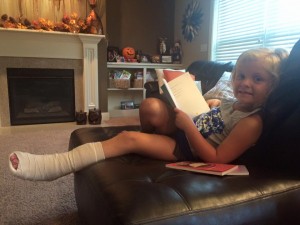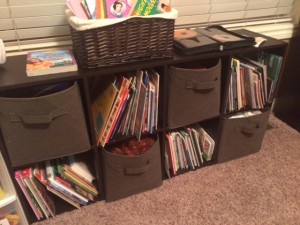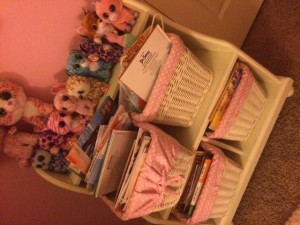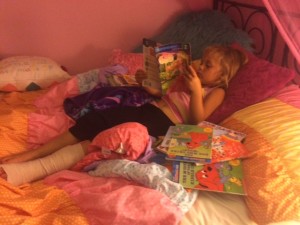A True Reading Emergency
For the first time in my tenure as a parent, I was confronted with x-rays, a fractured ankle, and a cast that came along with too much fun on a trampoline. With little outside or physical activity as an option, my daughter initiated a literal reading emergency. This emergency precipitated my reflection of how we develop readers in our home and at school. So often we refer to ‘reading emergencies’ at Dunlap Grade. Reading emergencies are glimpses of time that students grab a hold of to maximize their opportunities to read throughout the day. Our staff learned about this concept after reading books by Donalyn Miller; both the Book Whisperer and Reading in the Wild. You can read more about her at http://bookwhisperer.com/
Her books have become cornerstones of my professional reading library as well as helped in form our philosophy of teaching reading and developing a culture of readers at Dunlap Grade School. In addition to Donalyn Miller, we’ve been heavily influenced by the literacy work of Regie Routman. Both educators stress the importance of student choice, modeling reading, and engaging students in books that are appropriate, entertaining, and balanced.
Children need to love reading and books to become readers. Many may assume that the home of an educator includes pocket charts on the wall, strict visual schedules to follow, and stickers charts that reward positive behavior, but that doesn’t apply in our home. When I look at developing readers in my own children, it relies on some simple concepts that were made evident today following my daughter’s fractured ankle mishap. As we came home from the doctor’s office, her only choices for entertainment, due to her mobility constraints, were to read or color. She chose reading as she often does. I don’t drill her with flashcards, sight word practice, letter tiles, or word walls, rather, we foster a love of reading with a few simple principles.
For children to become lifelong readers:
1. They need to have access to a variety of books. Our shelves in our home are filled with book titles that span a variety of genres, reading levels, and topics. The shelves are centered in one particular location, but are rather filtered throughout the house. Our children have access to a wide range of reading material in the living room, basement, toy room, and their bedrooms. We even have a tub of books in the middle of the backseat for car rides and a book that consistently stays in the backpack for reading emergencies in the car or at school. Whereas our bookshelves aren’t pretty and organized by genre, our children are free to read a book, replace it in a location, and are often the first to be able to locate a particular title. Reading materials include board books that my 6 year confidently reads to our 15 month old daughter, highlights magazines, picture books, and beginners chapter books. It’s ok if your child goes through a “Fly Guy” phase or loves all the books in the Clifford Series. In fact, I just ordered a few more books in the Mercy Watson series as it is recently become a new favorite of ours. It’s okay (and in fact awesome) if your child loves to re-read the same book over and over. Those behaviors and reading choices lay the foundation for developing an independent reader. Babies and toddlers also benefit from access to a variety of books. Our youngest daughter loves pulling our 6 year old daughter’s books off the shelves and thumbing through the pages as much as she loves looking at pictures and connecting them to words in board books.
If you look closely, some of my reading material has also made it’s way to these shelves, and although they don’t read the words or understand the content in these books yet, it leads me to my next principle:
2. Children need to see models of lifelong learning and reading in the adults in their lives. Just as often as I sit and read a book to my daughter or have her read a book to me, I sit parallel to her and we individually read our own books. I document my reading life on www.goodreads.com and enjoy talking about the books I am reading with her. We consistently read the newspaper, articles, and mail in front of our children and model the importance of non-fiction text features in the mail we receive or articles we are reading. We need to ‘practice what we preach.’
3. Children benefit from real-world experiences that they can make connections to as they read later on. Those trips to the zoo, children’s museum or park are not only quality time spent as a family, but they provide children a context for reading later on. When they pull out a book, they can make important real world connections and apply their individual experiences to the contents of the text. Our children enjoy going to many community events that builds our bond as a family, but also develops their background knowledge that can/will be applied to their reading lives.
4. Children need time to read, immerse themselves in a book, and enjoy the tenants of reading. I am just as guilty as others of filling our schedule with sports, activities, and events. Whereas these all have tangible social and emotional benefits, it is also important to provide ample downtime that supports and encourages reading. We try to conserve the time before bed as our sanctuary for reading, but have also grown to love talking about or reading books in the car in between these activities. We try not to make reading “a chore,” but rather a time together that we look forward to and enjoy on a regular and consistent basis that is embedded into our schedule just as dinner time, bath time, and brushing your teeth are.
Whereas developing reading skills can be a complex process as students emerge from pre-reading skills in phonics to developing fluency and comprehension skills, the most important tenant is that we foster a love of print. Whereas I am sad that my daughter endured the pain of a fractured ankle and the inconveniences it will cause her in the next few weeks, I’m thankful to take a step back and see how the little, strategic elements of our home environment have fostered her love of reading and learning.







